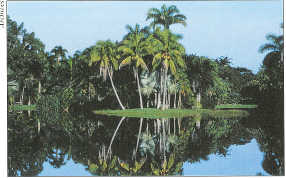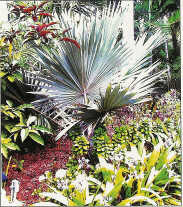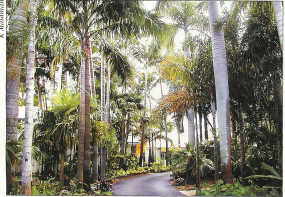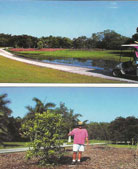Learning from William Lymon Phillips
Susan Knorr, Editor of Garden Views
 |
| A favorite view of Fairchild Tropical Garden |
I wish my garden looked like this. “It's so beautiful”, is a comment often heard from visitors to Fairchild Tropical Garden. Although few people could afford to reproduce the 83-acre landscape they admire, a garden that has a similar appeal is within many people's reach. A typical suburban lot can be transformed by using the same design principles Phillips used when he created the p1an for the Garden in the 1930s. Phillips was asked by Coronel Montgomery to create a botanical garden, but not given any idea of the character the Garden should have, or how the species should be organized. Montgomery only asked that it be “a garden rather than a park”. Homeowners will have an advantage over Phillips; they are not creating a botanical garden to suit a client without a clear idea of what he wanted, so their decisions can be based on their own preferences.
In a letter written in 1938, Phillips stated that although at first glance, the landscape plan he created had no “marked appearance of organization. . . there are clear purposes and principles underlying it.” These aesthetic qualities were contrast, variety and consistency.
The most distinctive aspect of Phillips’ design is the contrast between “mass and void,” a design term that in practice means heavily planted areas (mass) alternating with lawn or lake (void). As simple as this seems, it is just what is missing in many residential landscapes. Drive around Miami and you will see front yards planted with a tree in front, a couple of shrubs next to the house, and a few palms or an old mango tree to one side, floating in a sea of St. Augustine grass. It's no one's dream of tropical paradise. If this is what you are starting with, think of it as just that, a starting point. From now on, when you acquire new plants, group them. Plant a variety of shrubs, tall and short, around the tree, then surround the group with ground cover plants.
 |
| A grouping of interesting plants |
For example, if you have a solitary Hong Kong orchid tree (Bauhinia blakeana) with its light green, butterfly shaped leaves in your front yard, plant a couple of golden dewdrops (Duranta erecta), a tall shrub with shiny green leaves, between the tree and your property line, and some necklace pod shrubs (Sophora tomentosa), a lower-growing shrub with hairy, silvery green compound leaves, between the tree and your house. Both are easy to care for and attractive to wild life. Keep them close to each other, but also keep in mind their mature size. Then fill in with one or more ground covers, making a gently curved, irregular outline. Cut a sharp edge between your lawn (the void) and your new plantings (the mass). Besides emphasizing your design, this will make lawn care easier.
When you choose your plants, keep in mind another aspect of contrast, that between the individual plants. To continue our example, the broad leaves of low-growing gingers and ferns like the wart fern (Polypodium scolopendria) would contrast well with the finer leaves of the shrubs. Phillips regarded contrast as “indispensable to anything normally regarded as landscape.” Another aspect of contrast to keep in mind is color. Foliage greens vary greatly from blue-green to yellow-green, and there are also plants with foliage that is variegated green and white (Alpinia zerumbet variegata) and red (Acalypha wilkesiana ‘Musaica’).
Variety was expressed in Phillips’ plan by making the plot and lawn areas of different sizes and shapes. “The openings (of different sizes) were and remain the vital elements of the plan.” This, too, is a simple principle for a homeowner to adapt. When you are ready to continue your landscaping, perhaps with a grouping based on the existing foundation shrubs, make this another group of shrubs, trees or palms, and a ground cover, but change the overall shape and the individual plants. For example, this time you could add a group of slender palms like the Alexander (Ptychosperma elegans), fluffy-looking blue-flowered plumbago shrubs (Plumbago auriculata), and tie these together with the existing shrubs with the ground cover, gold lantana (Lantana ovatifolia var. reclinata). By considering both foliage and flowers, and remembering to use plants with different textures, your landscape will be interesting all year around.
 |
| The repetition of similar palms along a Garden member’s drive unites a variety of plants. |
Consistency: “The pattern, overall, is of a piece. The lines and shapes are dominantly free, casual, irregular, naturalistic . . . effects generically similar, specifically different.” This is particularly important in a small garden. Keep your vegetation irregular, so they look like they may have occurred naturally. By using a limited number of ground covers you can tie all these areas together. Also remember to leave enough space between the various planted areas for paths. These could be grass or, for lower maintenance, particularly in shadier areas, wood chips.
Although not specifically mentioned in his 1938 letter, Phillips also incorporated another design principle, that of repetition. In the examples above, you will notice that the suggestion is made to plant groups of the same plant. Although the plant “junkies” among us are always tempted to plant one each of many very interesting plants, to make an attractive landscape, you may have to control these impulses. Choose interesting, unusual plants if you like, but plant them in multiples. Another idea might be to integrate several specimens of a single species of slender palms, like Ptychosperma elegans, into a collection of dissimilar plants to provide pleasing repetition. This doesn't take much ground space but is strong enough visually to pull the rest together.
If you follow these basic premises, your property will eventually give the same impression Fairchild does, only on a smaller scale. There are many organizing principles for landscape design, but these seem particularly suited to the South Florida climate and topography. Again, in Phillips’ words “in Florida, small landscape units and close views of vegetation are apt to be more attractive than wide views, and walks in shade more agreeable than walks in sun.”
Thanks to Chuck Hubbuch Director of Collections for his insightful suggestions.
Garden Views September 2001
